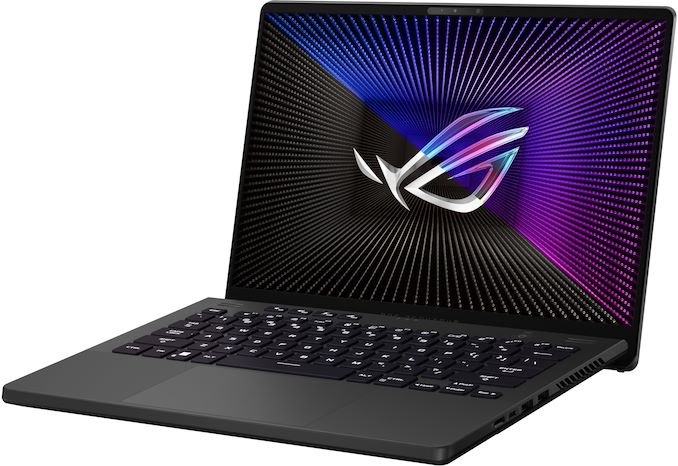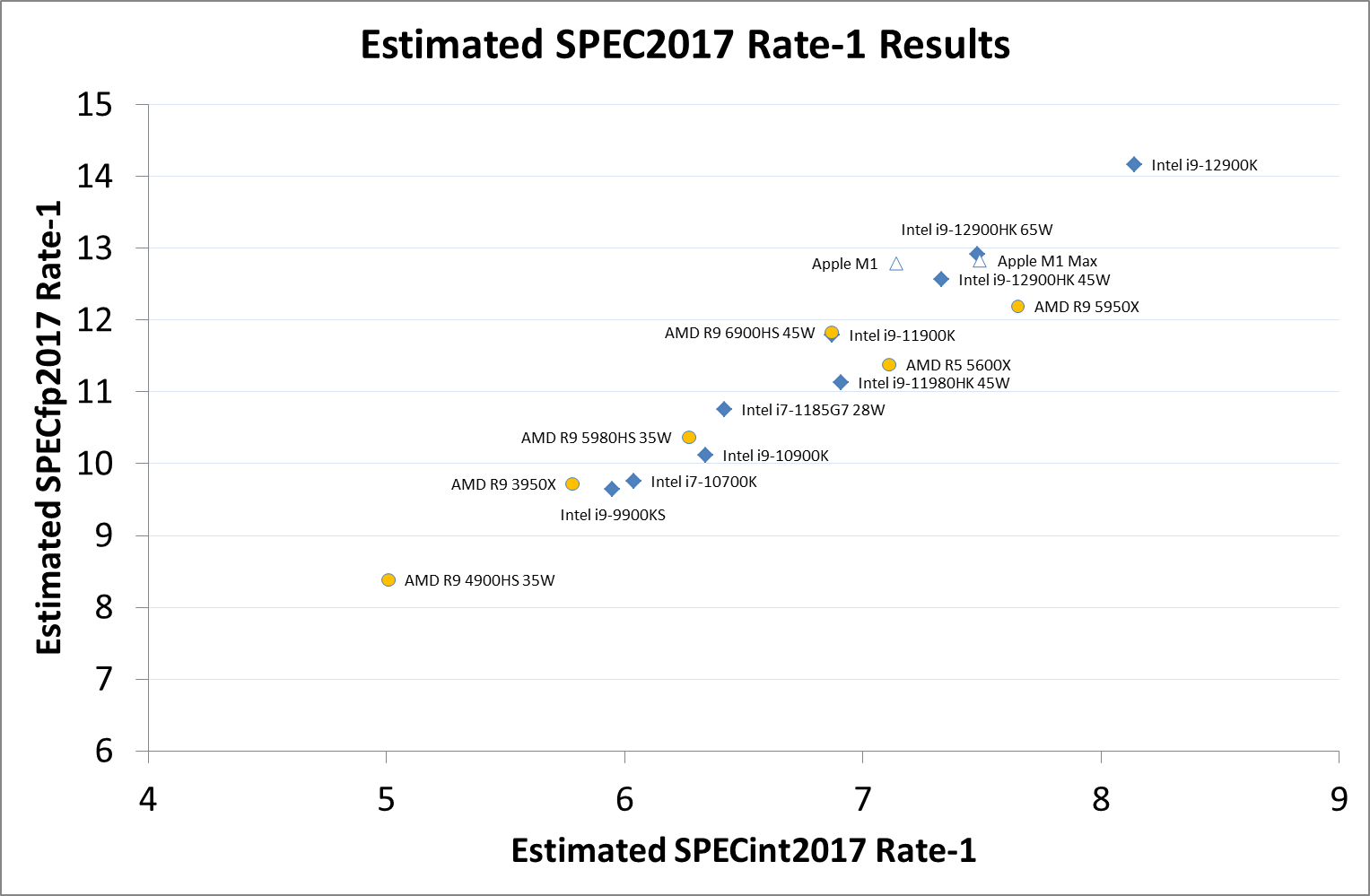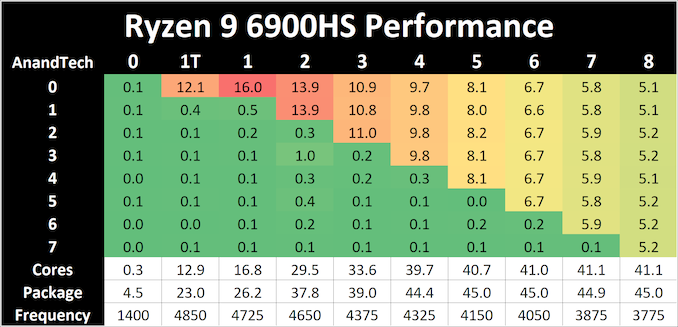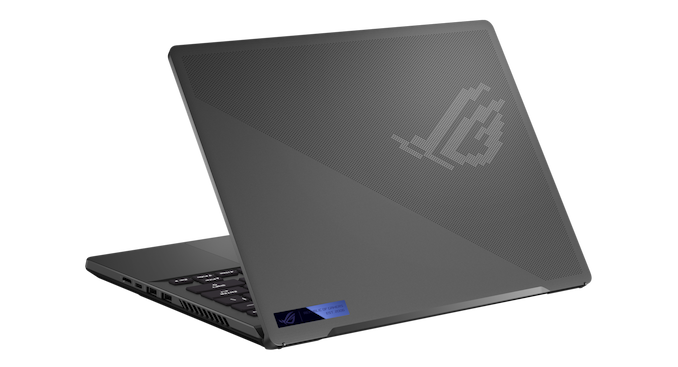AMD's Ryzen 9 6900HS Rembrandt Benchmarked: Zen3+ Power and Performance Scaling
by Dr. Ian Cutress on March 1, 2022 9:30 AM ESTConclusion
When AMD announced the new Ryzen 6000 Mobile series, codename Rembrandt, we saw a number of distinct upgrades over the previous generation: moving from TSMC 7nm to TSMC 6nm should provide a small efficiency boost, and then coupled with the move from DDR4 to DDR5 should greatly improve any memory-bound workloads. Instead of Vega graphics we now move to RDNA2 graphics, which should provide a much better gaming experience, coupled with that increased memory bandwidth. On top of that all, we were told about AMD’s 50+ updates to the SoC focused on power management, wake from sleep, and race to sleep. The one thing that we knew didn’t change was the CPU core: despite being called Zen3+, there is no difference in the microarchitecture compared to Zen3 – the reason why it gets a plus is due to the power management techniques, improved memory, and new manufacturing process.
But the fact of the matter is, CPU performance is more than just the microarchitecture and frequency. Beyond that, it’s the memory subsystem, which also contributes directly to IPC or performance per clock. This is why I’ve gone off iso-frequency testing for this sort of comparison, because each product is built with optimization points in mind, and moving simply the core frequency causes a different balance of resources compared to the ‘as built’ and ‘as sold’ metrics. This is why when we put Zen3+ up against Zen3 at a similar power level, we’re seeing a sizable uptick in performance.
In our industry standard SPEC tests, this translates to an +11.9% average increase for Zen3+ across integer and floating point in single threaded mode compared to Zen3. In multi-threaded mode at 35 W, this was a +10.4% for integer, but +32.4% for floating point. We saw a similar size jump in our multi-threaded floating point SPEC tests when Intel’s Alder Lake moved from DDR4 to DDR5, showcasing that there are key industry standard workloads for which DRAM memory bandwidth is still the limiting factor.
So while it’s a great move to see AMD jump into DDR5 with this new platform, the elephant in the room is still the performance against similar power hardware from Intel. Unfortunately we don’t have too many data points, as Brett in Canada tested the performance-focused 12900HK, and I’m the UK where I tested the efficiency-focused 6900HS, but suffice to say that in raw performance at least, comparing P cores to Zen3+ and multi-threaded workloads, Intel still has an advantage. Intel’s advantage increases when we increase the power, as it seemingly has more frequency to give, whereas AMD’s Rembrandt is already near peak all-core frequency at modest 35-45W power levels. This is showcasing one difference between the two manufacturing processes: AMD on TSMC N6, and Intel on Intel 7.
If we take something as simple as CineBench R20 (everyone’s favorite), the Intel CPU in 45 W mode scores 730, while the AMD CPU in 45 W mode scores 613, only matching Intel’s previous generation. That’s partly due to the single threaded power consumption on both platforms – while AMD is using 12.9 W on the cores (23 W package) to reach one thread at 4850 MHz, and doesn’t improve single thread performance in higher power modes, Intel does gets a performance uplift going from 45 W to 65 W, suggesting that the single thread power consumption is up in that region.
The same applies for multi-threading – in a lot of our benchmarks we see that AMD scores minor gains going from 35 W to 45 W to 65 W, indicating that the efficiency point is really around that 35 W metric. But when we scale that up to the multi-threaded tests, Intel can scale power for additional performance a lot more, but also wins as it has a total of 20 threads, compared to AMD’s sixteen. This means at the end of the day Intel can get +40% performance at the same power in benchmarks that can take advantage of its core structure, but only +14% in other tests (like SPEC) despite having +25% more cores.
While we haven’t touched battery life or graphics in this article, instead looking at CPU performance, we can see that realistically AMD is finding a good optimization point around that 35 W mark with this new Rembrandt chip. Pushing for more power gives minor performance uplifts, suggesting it isn’t really that scalable, but when we combine the new updated SoC with the move to DDR5, it’s still a great performer. In fact, both Intel and AMD chips seem to be amazing this generation, and if you’re in the market for a flagship, CPU performance is everywhere. But right now, Intel seems ahead at the high-end.
What’s going to be interesting here is testing the 15 W versions of the latest platforms. AMD still has 8 core processors, with all 8 cores being big cores, whereas Intel has moved down to 2 big cores paired with 8 efficient cores. We might see the tides shift the other direction allowing AMD to be more scalable, pushing 15 W or higher modes with more performance, while Intel relies on the efficient cores to pick up the rest of the workload. Ultimately this is where the battle really matters, as this is at the price points where most notebooks are going to be sold.
















92 Comments
View All Comments
ingwe - Tuesday, March 1, 2022 - link
While I understand not looking at battery life in this, not looking at graphics is a big miss._abit - Tuesday, March 1, 2022 - link
Back to pimping intel ever so gentlySarahKerrigan - Tuesday, March 1, 2022 - link
In 35/45W laptops, including this one, a dGPU will generally be present, making it a little moot. I expect more of a focus on graphics in the 15W review.Kangal - Wednesday, March 2, 2022 - link
Not at all.Most laptops (+80%) are below 45W TDP and they don't have a dGPU, and rely on the iGPU. It's a shame AMD has dragged their heels in this segment. For that reason, RDNA-2 is a substantial upgrade for most laptop users, but if you want a thick, heavy, Gaming Laptop then you are better off with the (12th-gen) Intel CPU and Nvidia dGPU (GeForce 30).
Besides, I see AMD's tech as eras:
2015-era, 16nm, Zen1, Vega Graphics
2018-era, 8nm, Zen2, RDNA-1 graphics
2021-era, 6nm, Zen3, RDNA-2 graphics
2024-era, 4nm, Zen4, RDNA-3 graphics
...roughly speaking (obviously years don't align)
And someone earlier asked how do these different GPU architectures compare. It's hard to do a true Potatoes-to-Potatoes comparison. However, from my understanding of the latest options it goes:
Qualcomm Adreno 7th-gen > Apple Graphics M1 > PowerVr IMG B-series > AMD RDNA-2 > Nvidia Ampere > ARM Mali Valhall 4th-gen > Intel Xe 1st-gen.
...obviously even the latest 4nm Adreno 730 when maxed out at 10W TDP, is no match against an older 8nm RTX 3050 that is thermal limited to only 100W TDP.
cbutters - Tuesday, March 1, 2022 - link
I hate to say it, but I agree.... this is literally one of the biggest step increases in iGPU performance; EVER, and nobody is talking about it. Why? Does Intel have input on how these articles are written? Or does it contribute to the ad revenue and people are wary of disrupting that? Its literally the MOST interesting thing about this CPU.JasonMZW20 - Tuesday, March 1, 2022 - link
Mostly because these systems ship with dGPUs. The iGPU in mobile Ryzen 6000 is a nice upgrade and simply demolishes anything Intel offers, currently.The mainstream 15-28W article should focus on iGPU, as these won't ship with dGPUs, usually. This is the meat of the market, and a good iGPU is critical to a good experience.
AMD's mobile strategy seems to be a quick-iterative design. Renoir and Cezanne were nearly on top of each other, as Cezanne came back from the fab just as Renoir shipped. So, with mobile Ryzen 6000/Rembrandt, AMD offers a new iGPU+(LP)DDR5 rather than new CPU cores, plus SoC optimizations overall.
The one thing that bothers me about the RDNA2 iGPU is that AMD disables an entire shader array in the 6600U instead of simply turning off 2 WGPs (4 CUs). So, there's a sharp performance drop between the two models and 6600U will be the primary volume seller, I think. 12 CUs to 6 CUs, instead of 12 -> 8 -> 6.
DannyH246 - Tuesday, March 1, 2022 - link
Honestly it’s been like this for a while now. Just go to the home page and count how many Intel marketing articles we’ve had over the last couple months. Now we get a half arsed joke of a review like this on AMD hardware. Obviously in Intel’s pocket.29a - Tuesday, March 1, 2022 - link
Typical half assed AMD article.DannyH246 - Tuesday, March 1, 2022 - link
Next headline article on www.IntelTech.com….Breaking news Intel CEO Gelsinger breaks wind.
Qasar - Wednesday, March 2, 2022 - link
DannyH246 i see you cry about this all the time, if anandtech is that bad, WHY do you keep coming here ? is it just to whine and cry?? im sure you will just reply with some sort of BS, but it HAS been stated before, there are times when most articles are intel, and others are AMD, its just the way the cycles go.